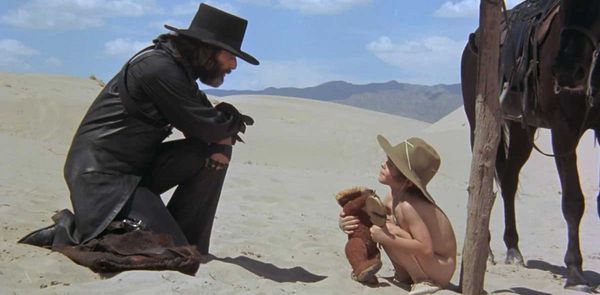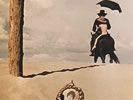Eye For Film >> Movies >> El Topo (1970) Film Review
El Topo
Reviewed by: Anton Bitel

"If you are great, El Topo is a great picture. If you are limited, El Topo is limited."
So says Alejandro Jodorowsky, writer, director and star of the 1970 cult hit El Topo - but before getting to the film's greatness, and its limitations, it is worth looking at the man behind the film. Born in Chile to émigré parents, Jodorowsky had a thirst for knowledge which led him to Paris, then to Mexico City (where most of his films were made), and finally back to Paris. He has been a circus clown, a puppeteer,a cartoonist, a mime artist (who designed several of Marcel Marceau's most famous routines, when he was not bedding the French artist's wife), a revolutionary Sixties theatre artist, a surrealist, a tarot reader, an intellectual, a spiritualist and an all-round prankster-provocateur. Most recently, he made the news in 2005 when he was invited to officiate at the wedding of Marilyn Manson and Dita Von Teese. But he will always be best known as one of the world's most eclectic and visionary avant-garde filmmakers.

His first feature, the apocalyptic love story Fando y Lis (1968), caused riots when it premiered at the Acapulco Film Festival, and was banned shortly afterwards by the Mexican government, who came very close to deporting Jodorowsky as well. Unperturbed, the director turned his mind to El Topo, a 'spaghetti eastern' whose generic frame as an oater can barely contain its outlaw ideas. Sure its protagonist El Topo is a horse-riding, pistol-toting, sombrero'd man-in-black who has gunfights with all comers, but this film relates to the conventional cowboy flick much as Jodorowsky's later Santa Sangre (1989) relates to the conventional slasher. Nope, this is a mystic trip through political, religious and philosophical terrains, gunning down all normative notions of what the western - or indeed Western civilisation - is supposed to be.
The documentary footage of moles that opens El Topo (or 'The Mole') serves a double purpose: it allies the film to Luis Buñuel and Salvador Dali's surrealist classic L'Âge d'Or (1930), which similarly began with a documentary on scorpions; and it establishes from the outset the film's 'underground' status, by associating it with a creature whose natural habitat is below the earth's surface and out of the light.
El Topo (played by Jodorowsky himself) is journeying on horseback with his young son (played by Jodorowsky's real-life son Brontis), when they chance upon a village where a bloody massacre has taken place. The gunslinger tracks down the man responsible, a tyrannical colonel (David Silva), whom he defeats and emasculates in a duel, catching the attention of the colonel's woman, Marah (Mara Lorenzio). She persuades El Topo to abandon his son to some monks and to take on the four Masters of the Gun (Héctor Martínez, Juan José Gurrola, Victor Fosado, Augustín Isunza) in the desert as a test of his prowess. In a sequence of stylised gunfights, El Topo bests the Masters one by one using a combination of ruthlessness, trickery, and chance too great to be blind - only to be shot by the treacherous Marah and their travelling companion the 'woman in black' (Paula Romo).
In the film's second half, set decades later, El Topo revives to find himself being tended and worshipped by a cave-dwelling colony of cripples and freaks who believe he will be their Saviour. After a drug-taking rite, El Topo swears he will dig a tunnel to free the troglodytes from their mountain prison. Sporting a shaven head and a new sense of humble piety, El Topo sets off with a small woman (Jacqueline Luis) to the town below, hoping that their mime act will help raise the money and supplies needed for the dig. Down in the town, however, what they find is greed, corruption, hypocrisy, carnality, blasphemy, perversion, xenophobia, despotism and cold-blooded murder - it's a mirror of the US, don't you know? They also find El Topo's son, now an adult (played by Robert John), looking to settle the score with his born-again father.
While this approximates a synopsis of El Topo, it barely begins to convey what the film is like. For Jodorowsky's over-coded assemblage of resonant images, biblical parables, political satire and theosophical allegory washes over viewers in a kaleidoscopic deluge, defying any sort of simplistic interpretation, and confounding anyone in search of an easy ride. The film's titular protagonist is all at once a cowboy Christ, a mystic initiate, an anti-establishment rebel, and a figure for the whole underground movement, trying to lead his army of outcast misfits to the public marketplace - with tragic consequences.
No surprises, then, that the film found its first approving audience with the disaffected, countercultural pot-heads who, in the early Seventies, were beginning to congregate for special screenings held at the witching hour. Showing exclusively in the late-late slot at New York's Elgin Theatre with little fanfare, El Topo was to become the first successful 'midnight movie', winning for itself through word of mouth alone a highly devoted niche audience that would pay to see it again and again and again, for a mind-expanding experience that no other film could quite provide. Its early champions included John Lennon and Yoko Ono, who were behind an effort to get the film's rights purchased by a more conventional distributor for round-the-clock screenings. Once brought out of the darkness and into the mainstream, like its cave-dwelling characters it suffered an almost instantaneous death - but at least Lennon and Ono made up for their error of judgement by producing Jodorowsky's next cosmic experiment in cinema, The Holy Mountain (1973).
Seen again today, El Topo may look a bit dated, its bloody violence may have lost some of its shock value, and it may seem more than a tad self-indulgent (which, in fact, it seemed even upon its release in 1970). Yet, while he is certainly influenced by both Buñuel and Federico Fellini, there is nobody who makes films quite like Jodorowsky's, and El Topo is one of his finest. In it, he stretches his low budget to its extremes to produce some highly beautiful and haunting imagery, he juggles clashing symbologies with a deftness and underlying intelligence that are mesmerising, and his breath-taking provocations stick up two fingers to the system outside of which, both miraculously and necessarily, this film was produced. There are now many movies with more sensational thrills and more hallucinatory effects, but few could claim to have as many ideas.
So see it, experience it, and find out both how great and how limited humanity can be.
Reviewed on: 31 Mar 2007

















